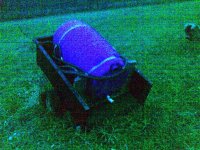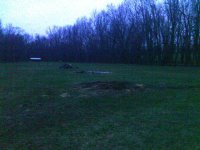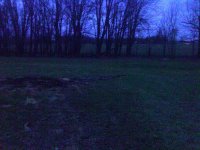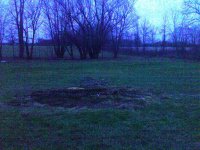You are using an out of date browser. It may not display this or other websites correctly.
You should upgrade or use an alternative browser.
You should upgrade or use an alternative browser.
Medium brush fire water rig ideas and questions
- Thread starter aczlan
- Start date
- Views: 12688
More options
Who Replied?
/ Medium brush fire water rig ideas and questions
#11
muddstopper
Veteran Member
Probably the cheapest and easiest route would be to look for a old used hydroseeder. Look for a plastic tank recirculating type to save on weight. Used ones are a fraction of the cost of new. Some are trailer and some are skid mount. Sizes start around 100gal and can go upto 4000gal. The small 100gal skid mounted machines can be carried in a golf cart and at 8lb per gal you can figure your needs for the larger machines. Advantages are that it is a fully self contained unit, complete with water pump and discharge hose. Different types of nozzels can be interchanged according to needs, fan types for just wetting down close areas, or 100ft long distance nozzels for large streams of water. These machines can also be used for mixing ice control solutions for treating driveways and dust control by using approved dust control products. Might as well have something you can make money with when you aint fighting fires.
CompactTractorFan
Super Member
How much are you thinking of spending? I often see used, working fire trucks on CL for dirt cheap. Seems like it would save you a lot of troube and it would be way cool!
I like that idea the best.
Here is a reputable used fire equipment that has a "bargain" section featuring apparatus that cost less than $10,000:
Firetec Home Page
scollins
Silver Member
Not too far from you is the Finger Lakes National Forest ranger station.
Pay them a visit and ask them to show you what they are using for grass, brush and forest fires. Some places need the big 1.5" hose, but we extinguish 90% of the fires with a 3/4" hardline on a reel.
Take a look at the tools, swatters, fire rakes, etc. In many areas in the Eastern Hardwood Forest region, they use backpack leaf blowers to construct fire breaks through the leaves.
Also might check out a NY State forestry station.
Up here, the US Fish & Wildlife Service fire program uses Polaris Ranger 6x6 UTV's with a tank, Honda WX15 pump and small hose on a reel.
Here is a similar unit that is used by a nature conservancy in Wisconsin for holding their fire breaks on prescribed burns.
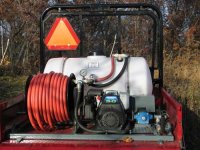
If you cannot extinguish a spot fire with the Workman, 60 gallon plastic tank, pump and 100' of 3/4" Ag hose with garden hose nozzle, you need to have the Fire Department out there, anyway.
As someone already mentioned, prevention is "key", and I stress the "right" conditions - not just the night of the bonfire, but the extended forecast as well. If the relative humidity is in the thirties, you can get spotting, If the RH is in the 20's, expect to be needing the fire department when the wind comes up.
This is not the forum to try to make you a "burn boss", but take a look at the parameters, below, for burning and remember the 40-60 rule - relative humidity at or above 40% and temperatures at or below 60 degrees and you should be able to handle anything with a garden hose off a sprayer in your neck of the woods (this does not pertain to California, Australia, Pitch pine of east coast, etc.)
http://okfire.mesonet.org/sub_info/OK-FIRE Basics for PRESCRIBED BURNING.pdf
The burn article I saw mentioned that spot fires can occur from a large pile, 500 feet away.
When things "green up" in the Spring, the danger is lessened.
Good luck and send photos of the site.
SC
Pay them a visit and ask them to show you what they are using for grass, brush and forest fires. Some places need the big 1.5" hose, but we extinguish 90% of the fires with a 3/4" hardline on a reel.
Take a look at the tools, swatters, fire rakes, etc. In many areas in the Eastern Hardwood Forest region, they use backpack leaf blowers to construct fire breaks through the leaves.
Also might check out a NY State forestry station.
Up here, the US Fish & Wildlife Service fire program uses Polaris Ranger 6x6 UTV's with a tank, Honda WX15 pump and small hose on a reel.
Here is a similar unit that is used by a nature conservancy in Wisconsin for holding their fire breaks on prescribed burns.

If you cannot extinguish a spot fire with the Workman, 60 gallon plastic tank, pump and 100' of 3/4" Ag hose with garden hose nozzle, you need to have the Fire Department out there, anyway.
As someone already mentioned, prevention is "key", and I stress the "right" conditions - not just the night of the bonfire, but the extended forecast as well. If the relative humidity is in the thirties, you can get spotting, If the RH is in the 20's, expect to be needing the fire department when the wind comes up.
This is not the forum to try to make you a "burn boss", but take a look at the parameters, below, for burning and remember the 40-60 rule - relative humidity at or above 40% and temperatures at or below 60 degrees and you should be able to handle anything with a garden hose off a sprayer in your neck of the woods (this does not pertain to California, Australia, Pitch pine of east coast, etc.)
http://okfire.mesonet.org/sub_info/OK-FIRE Basics for PRESCRIBED BURNING.pdf
The burn article I saw mentioned that spot fires can occur from a large pile, 500 feet away.
When things "green up" in the Spring, the danger is lessened.
Good luck and send photos of the site.
SC
